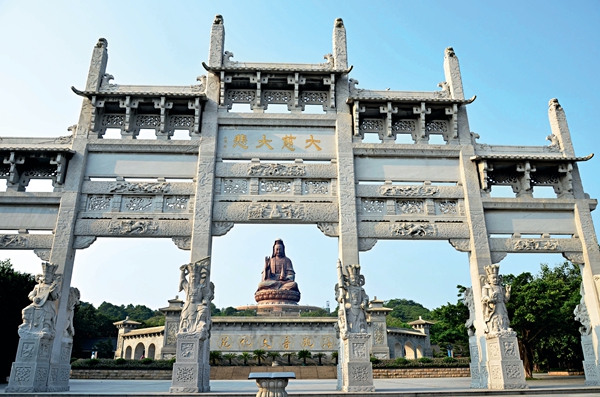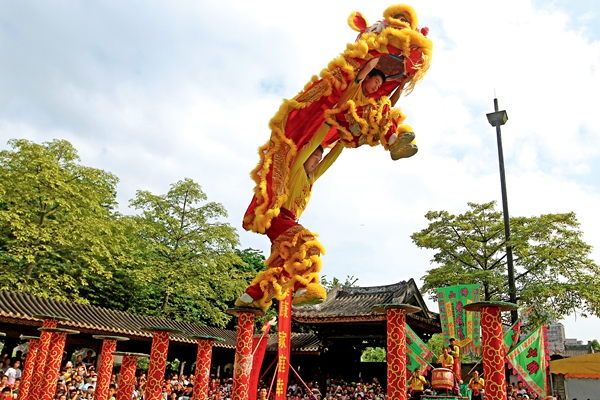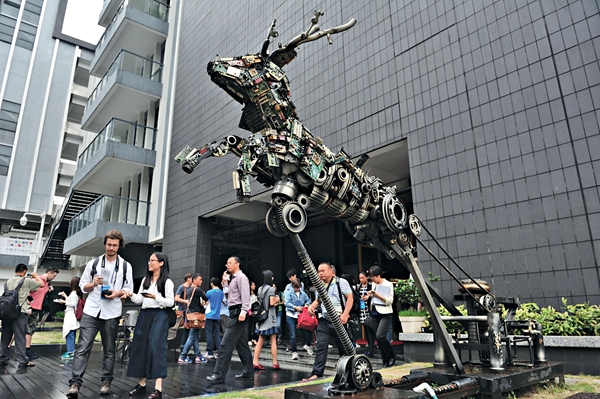For centuries, Foshan has been the economic and trade center in this region, and known for its high-quality ceramic products throughout the country. In modern times, it has witnessed a growth in modern manufacturing, and hence became one of the cradles nurturing China’s domestic industries.

Foshan is birthplace of the Cantonese Opera that is still popular in Guangdong, Hong Kong, and other Cantonese-speaking areas. It also represents an important school of Chinese Kung Fu. The city has abundant tourism resources, both cultural and natural, such as Xiqiao Mountain, Qinghui Garden, and Liangyuan Garden.
Representative of Guangfu Culture
Literally, Foshan means Buddha’s mountain. As the legend goes, in the year 628, three bronze Buddha statues were dug from inside a mountain. When people moved the statues, springs welled up. Locals believed it was the site of an ancient temple that an eminent monk from Shanbin (now in Kashmir) set up. People built a well and rebuilt the temple to worship the three Buddhas. Later, the place was renamed Foshan, Buddha’s mountain.
Foshan and Guangzhou, geographically connected, serve as the powerhouse of the Guangfu Culture, an influential sub-culture of Lingnan Culture (a prominent culture in South China). Distinctive by the Cantonese dialect, the Guangfu Culture is profoundly influential in the Pearl River Delta.
Cantonese Opera, the gem of this culture, locally called Guangdong big opera, saw its heyday in the mid-16th century, when the first guild was established in Qionghua Hall for monitoring troupes. The hall worshipped the opera’s founder Hua Guang, and was the venue for troupes’ practice, rehearsals, and exchange. In the 1840s, Cantonese Opera started to disseminate to Hong Kong that had just opened as a commercial port, and then further to Singapore and Malaysia where the opera still remains prosperous.
Craftsmanship also thrives in Foshan, represented by their papercuts, colored lamps, “autumn color” parade, and wood-print block paintings.
The “autumn color” is a big carnival held during the harvest season. Delicate handiworks are made for road shows; the dragon dance and lion dance are performed to the accompaniment of shifan (a band of 10 instruments) and a special musical instrument called luogugui. The props of the dragon and lion dances are hand-made from paper and bamboo splits. For making a lion head alone, as many as 1,300 steps are needed.
The City of Kung Fu
With a history of thousands of years, Chinese Kung Fu has developed to a sprawling art with a dazzling range of styles and mysterious spiritual contents. Simply put, Chinese Kung Fu can be divided into two major schools – the North School and the South School. The former is led by the Shaolin Temple, while the latter is based in Foshan.
For centuries, Foshan was economically affluent. Seated on the artery to the regional center of Guangzhou, Foshan is very strategic for military purposes. However, the narrow and flat terrain makes it difficult to defend itself. For self-defense purposes, locals maintained the tradition of practicing Kung Fu. In the early 20th century emerged a large number of martial art sects and boxing masters with global influence. Widely popular boxing schools, such as Choy Li Fut, Hong Boxing, and Wing Chun all originated in Foshan. Famous masters like Wong Fei-hung, Liang Zan, and Yip Man were born or grew up in Foshan.
Bruce Lee was also a descendent of Foshan emigrants. Integrating the essence of other martial arts of the world, he created an all-round free boxing school – Jeet Kune Do. Lee brought ancient Kung Fu to the lime lights of Hollywood and made it more popular worldwide. He himself became the incarnation of Chinese Kung Fu.
Another legendary Kung Fu master is Wong Fei-hung, who is the key person in the development of the South School. Born to a martial arts family in 1847, Wong learned Kung Fu from his father since childhood. He was also a famous traditional Chinese medicine doctor, winning fame for medical skills and benevolence. Wong was the prototype of more than 100 movies and TV dramas. For decades, he devotedly taught students and promoted the Hong Boxing. His disciples and disciples’ students can be found across the world.

Comparatively, the lion dance and dragon dance are more entertaining. Popular all over the country, they can also be divided into two styles – the south and the north. The south lion dance distinguishes itself by a horn on the lion’s head and the heated music, which earned it the name “awakening lion.”
Nanhai in Foshan is just where the south style of the lion dance originated, which later spread to the whole province, neighboring Guangxi region, and then Southeast Asia. The design and color of these so-called south lions are exaggerated, showing the strength and virility of the animal. The lion head and body are made separately, and played by different actors. The accompanying music is played using a big drum, big gong, and cymbals, which sounds exciting and rousing.
Caiqing, or plucking green, is the unique, core part of the performance. Green vegetable is hung high on a two-meter-high pile of wood. Two lions dance and fight to be the first to ascend the pile; and the winner is whoever first eats the vegetable. The thrilling performance always creates loud shouts and cheers from the crowd, creating a festive environment. The craftwork of making the lion heads and bodies in Foshan enjoys a reputation at home and abroad.
Manufacturing Center
Foshan is located on the upper reach of the waterway to Guangzhou, so has long been a transportation hub in the Pearl River Delta. Since the seventh century, the city has long enjoyed prosperous commerce, which stimulates the craftsmanship and other manufacturing. In the 14th century, Foshan became a regional center for collection and distribution of goods, and a center of producing ceramics, textiles, and herbal medicines. At that time, on a national scale, it had the same importance as Beijing, Hankou in Hubei Province, and Suzhou in Jiangsu Province.

In the second half of the 19th century, Foshan witnessed the emergence of domestic modern industries. It was here that China’s first modern reeling factory and first match factory were established.
Since China adopted the reform and opening-up policy in the late 1970s, Foshan soon built up its manufacturing capacity, in particular, home appliances, mechanical equipment and instruments, metal material products, ceramic and building materials, and textiles and garments. More than 500 brands have been listed “famous brands” by the Guangdong provincial government. Foshan has become synonymous with manufacturing.
Shunde District is a testament to the pulse of the Chinese home appliance industry. About 30 years ago, it was a mecca for all household appliance factories to flock to. The district is home to dozens of home appliance manufacturers, such as Kelong, Midea, Galanz, to name a few. It produces one-fifth of China’s home appliance products, contributing to the country’s title as “World’s biggest home appliance producer and exporter.”
A vibrant private economy serves more than 60 percent of Foshan’s economic aggregation, much higher than other cities in China. Now, industry in Foshan has switched to smart manufacturing. At the end of 2016, more than 300 companies above designated scale engaged in intelligent equipment, about 100 of which in the R&D of robots.
Foshan has more than 700 years of experience in making ceramic production. The Nanfeng Kiln, built between 1506 and 1521, is the world’s extant oldest firewood-burnt long kiln (thus called dragon kiln) and is still used today. In its heyday during the Qing Dynasty (1644-1911) there were a total of 107 kilns in Foshan. The city remains a ceramic production base, playing a significant part in China’s ceramic industry.
(Compiled by China Today)